|
Additional Lessons |
 About These
Lessons About These
Lessons
The following classroom lessons are great for students
who want additional listening and reading practice. |
-
Travel America -
Beginner
Level. Do you love America and American
English? Learn before you travel. Facts and other
cool stuff about your favorite U.S. state. Great
English reading practice.
|
 Travel
America - Tennessee Travel
America - Tennessee
(Beginner -
Reading)
Learn some interesting facts and read interesting
stories about Tennessee. |
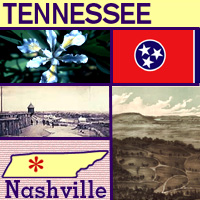 Tennessee Tennessee
Called the "Volunteer State," Tennessee became the
16th state of the Union in 1796. It was the first
territory admitted as a state under the federal
Constitution. Before statehood, it was known as the
Territory South of the River Ohio. The name
Tennessee is derived from the name of a Cherokee
village, Tanasi. Today, the capital, Nashville, is
known as a center for country music. Memphis, the
largest city in the state, is the place where Elvis
Presley first began his legendary musical career.
The state flower is the iris. |
Tennessee
State Flag
The state flag of Tennessee has three stars
representing the "grand divisions" of the state: East,
Middle, and West. The stars are "bound together in
indissoluble unity by an unending white band" (officially
adopted in 1905).
Tennessee's flag was designed by LeRoy Reeves of the Third
Regiment, Tennessee Infantry. His explanation of the design:
"The three stars are of pure white, representing the three
grand division of the state. They are bound together by the
endless circle of the blue field, the symbol being three
bound together in one - an indissouluble trinity. Thelarge
field is crimson. The final blue bar relieves the sameness
of the crimson field and prevents the flag from showing too
much crimson when hanging limp. The white edgings contrast
more strongly the other colors."
Tennessee Flag Salutes
There are two official salutes to the Tennessee flag, both
adopted in 2006. The first salute was written by Lucy Steele
Harrison:
"Three white stars on a field of blue
God keep them strong and ever true
It is with pride and love that we
Salute the Flag of Tennessee."
The second salute to the Tennessee flag was written by Miss
John Bostick:
"Flag of Tennessee, I salute thee
To thee I pledge my allegiance with
My affection, my service and my life." |
|
Source:
State Symbols USA |
|
|
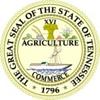 Tennessee
State Facts Tennessee
State Facts
Picture: state seal of Tennessee |
|
State Capital |
Nashville |
|
Nickname |
Volunteer State |
|
Motto |
Agriculture and Commerce |
|
Statehood |
June 1, 1796 (16th) |
|
Origin of Name |
Named after Cherokee Indian villages called "Tanasi" |
|
Largest Cities |
Memphis, Nashville, Knoxville, Chattanooga,
Clarksville |
|
Border States |
Alabama, Arkansas, Georgia, Kentucky, Mississippi,
Missouri, North Carolina, Virginia |
|
Area |
41,220 sq. mi., 34th largest |
|
State Bird |
Mockingbird |
|
State Flower |
Iris (iridaceae) |
|
State Tree |
Tulip poplar (liriodendron tulipifera) |
|
State Song |
The Tennessee Waltz, Tennessee, My Homeland,
Tennessee, When It's Iris Time in Tennessee, My
Tennessee, Rocky Top |
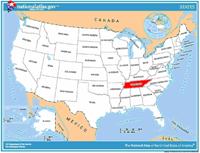 Travel and tourism site for Tennessee - This
state travel and territorial tourism site provides ideas for your
vacations, meetings, and more. Travel and tourism site for Tennessee - This
state travel and territorial tourism site provides ideas for your
vacations, meetings, and more. |
|
|
Tennessee Stories |
|
|
World's Biggest Fish Fry
Why is there a giant catfish on top of that sign for Paris,
Tennessee?
Because Paris is home to an event that claims to be the "world's
biggest fish fry." Hungry visitors will consume more than 13,000
pounds of catfish during the festivities, which last for six days.
The event began in 1953 and includes parades, square dances, an auto
show, and, if you're lucky, a catfish race!
Do you know how Paris, Tennessee, got its name? It was named after
Paris, France, to honor the homeland of Revolutionary War hero
Lafayette, whose full name is Marquis de Lafayette, Marie Joseph
Paul Yves Roch Gilbert du Motier! He had fought with George
Washington's army and visited Tennessee in the early 1800s. |
|
|
Grand Ole Opry
Do you know how the Grand Ole Opry got its name?
It began as a live music show at radio station WSM in Nashville,
Tennessee. Started by radio announcer George D. Hay in 1925, it was
originally called "The WSM Barn Dance," and it featured live local
musicians.
In 1927, George Hay's radio program followed a classical music show.
He joked that the audience had been listening to grand opera, but
from then on the station would be presenting "the grand ole opry."
The name stuck and has been used ever since.
At first, some people in Nashville were against the mountain folk
music the Opry promoted. Nashville was trying to present a cultured
image, and some local leaders believed that the rural music Hay had
on his show presented the wrong image. Nevertheless, people began to
drop by to watch the musicians performing through the small studio
window. Then the radio station decided to let the people in, hoping
an audience would liven up the show. After a while, the crowds got
so big that they had to move to a larger studio to hold the
audience!
Over the years, the show continued to expand. The Grand Ole Opry is
the longest-running live radio program in the world. Almost a
million people visit the Opry every year to see their favorite
stars. Musicians like Hank Williams, Roy Acuff, Randy Travis, Dolly
Parton and Garth Brooks have performed on the stage at the Opry, as
have hundreds of others. |
|
|
Central High School: A Salute to Morgan
County Veterans
Every American owes a great deal to those who have served in the
military. Many Americans have given their lives in service to their
country and we honor them on Veterans' Day.
For years, Veterans' Day in Wartburg, Tennessee, was celebrated at
Central High School every November 11 with local veterans from the
American Legion who would stop by and put on a program, educating
students about the people who served their country. But by the early
1990s, the tradition had faded and it wasn't revived until 1999.
This time, the students themselves were responsible for the tribute
at their school. With the help of their teacher, Jean Carson, they
interviewed local war veterans and then researched, planned, and
organized the event. They put together a booklet with the names of
all Morgan County veterans. When they put on the Veterans' Day
celebration, veterans, students, teachers, and other community
members came. Two World War II veterans addressed the crowd,
speaking on their war experiences and the benefits of a career in
the military. The school choir and band performed patriotic songs.
Visitors could see military uniforms, medals, photos, and other
memorabilia that were on display. The program not only helped honor
those who had served in the military, but also gave the students a
chance to meet local veterans and hear their stories firsthand.
Building on the success of this Veterans' Day program, the students
and faculty plan to carry on the tradition in years to come. |
|
|
Birthplace of Country Music
Where was country music born? If you said Nashville, you'd be wrong.
The right answer is Bristol, Tennessee. Bristol is on the Tennessee
and Virginia border, where Appalachian mountain folk music has been
popular for generations. Many of the fiddle tunes and song styles
came over from the British Isles in the 1700s.
By the early 1900s, the recording industry had begun, but most
musicians had to travel to New York City to record their music. In
1927, Ralph Peer of Victor Records decided to try something
different. He went to Bristol, Tennessee, to record local musicians.
He thought that old-time and "hillbilly" musicians could be found
there. Two local acts signed recording contracts -- the Carter
Family from Virginia and former railroad worker Jimmie Rodgers of
North Carolina. While the Carter Family played old-time mountain
music, Jimmie Rodgers sang ballads and used a singing style called
yodeling. They both became successful nationwide. The Carter Family
formed the core of several generations of popular country musicians,
and Rodgers's 1928 recording of "Blue Yodel" became one of the first
country records to sell a million copies!
These early Bristol recordings laid the groundwork for much of the
country music that followed. Because Bristol is not usually thought
of as the place where country music began, it was especially
important that the U.S. Congress recognized Bristol's contribution
to music history. In 1998, Congress passed a resolution recognizing
Bristol as the "Birthplace of Country Music." |
|
|
Mule Day
Do you know where a mule comes from? It is the offspring of a donkey
and a horse. Mules have strong muscles like horses but they eat
less, can work longer, and are gentler, like donkeys.
Every April, Maury County holds a Mule Day celebration. Held in
Columbia, Tennessee, Mule Day had its beginnings as "Breeder's Day"
in the 1840s. Farmers and livestock breeders would bring their
animals to market every April to show, buy, and trade. This was an
important business before the days of tractors, when many families
made a living from farming and mules were used as work animals.
Eventually, tractors began to replace mules, making them less in
demand.
A parade was added to Mule Day in 1934 to attract more people. Over
the years other activities have been added, and today more than
200,000 people show up each year to watch and participate. If you
visit on Mule Day, you might see a mule-driving contest, a square
dance, a crafts festival, or even a lumberjack competition. |
|
|
Tennessee Valley Authority
One of the most famous and successful projects begun by the federal
government during the Great Depression was the Tennessee Valley
Authority, or TVA. Do you know what it was and why it was started?
During the Great Depression of the 1930s, President Franklin D.
Roosevelt set up many new projects and agencies to help the hardest
hit areas of the United States. One such agency was the Tennessee
Valley Authority, which was created in 1933. The Tennessee River
valley was continually dealing with floods, deforestation, and
eroded land. The TVA aimed to help reduce these problems by teaching
better farming methods, replanting trees, and building dams. This
agency was also important because it generated and sold surplus
electricity, created jobs, and conserved water power. The TVA was a
great success almost from the beginning and helped ease some of the
economic hardship not only in the state of Tennessee but also in
parts of Kentucky, Alabama, Georgia, North Carolina, and Virginia. |
|
|
The National Storytelling Festival
Almost 30 years ago, a Jonesborough, Tennessee, high school
journalism teacher was listening to his car radio with a group of
students. They heard a funny tale about raccoon hunting told by
storyteller Jerry Clower. This experience gave the teacher, Jimmy
Neil Smith, an idea: He would start a local storytelling festival.
Around 60 people showed up for the first one in 1973.
Today, Jonesborough is the home of the National Storytelling
Festival, which attracts more than 10,000 visitors every October.
Storytellers come from all over the world to entertain and educate
at this three-day festival. Many tell tales and ancient myths from
their faraway homelands. Others tell stories with local settings.
Visitors can wander through festival tents and listen to a variety
of stories -- hilarious tales, age-old myths or cowboy poetry.
Thanks to this festival, there has been a renewed interest in
storytelling, not only as a way of sharing information but also as
an art form.
Today, the National Storytelling Festival is the oldest and most
respected gathering devoted to the art of storytelling anywhere in
America. This unique event has influenced a national revival of the
storytelling art. |
|
Source:
Library of Congress |
|
 National
Forests and Parks of Tennessee National
Forests and Parks of Tennessee
The following is a description of national
forests and parks in the state
of Tennessee. There are no national
monuments in this state. If you plan to visit or live
in Tennessee for awhile then you should
definitely plan to visit some of these
fantastic places. |
|
|
|
National Forests |
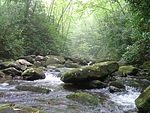 Cherokee Cherokee
Cherokee National Forest has eleven
wilderness areas, three large lakes, and
over 600 mi (970 km) of trails, including
150 mi (240 km) of the Appalachian Trail in
the Great Smoky Mountains. There are 43
mammal species, 154 fish species, 55
amphibian species, and 262 bird species in
the forest. This national forest is also
partially located in the state of North
Carolina. |
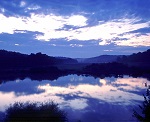 Land
Between The Lakes Land
Between The Lakes
Land Between The Lakes National Recreation
area is located in Western Kentucky and
Tennessee, and encompasses over 170,000
acres of forests, wetlands, and open lands
on the largest inland peninsula in the
United States. It is located between
Kentucky Lake and Lake Barkley. This
recreation area is also partially located in
the state of Kentucky. |
|
|
|
National Parks |
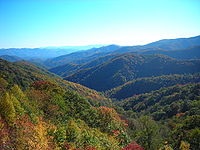 Great
Smoky Mountains Great
Smoky Mountains
The Great Smoky Mountains, part of the
Appalachian Mountains, span a wide range of
elevations, making them home to over 400
vertebrate species, 100 tree species, and
5000 plant species. Hiking is the park's
main attraction, with over 800 miles (1,300
km) of trails, including 70 miles (110 km)
of the Appalachian Trail. Other activities
include fishing, horseback riding, and
touring nearly 80 historic structures. This
national park is also partially located in
the state of North Carolina. |
|
|
Travel America |
|
|
Great Smokies National Park
(Beginner - Listening,
reading)
A video lesson which shows you an interesting place in America.
The English is
spoken at 75% of normal speed.
Great English listening and reading practice.
This video is all about Great Smokies National Park. |
|
 Travel
America Travel
America
Do you love America and American English? Learn before
you travel. Facts and other cool stuff about your
favorite U.S. state. Visit the Fun Easy English Travel
America pages. Read about the beautiful National
Forests, Parks, and Monuments. Great English reading practice. |
 Drive America Drive America
Planning to drive in America? Learn the rules and
regulations. Great English reading practice. |
|